Emerson NXL UPS Systems User Manual
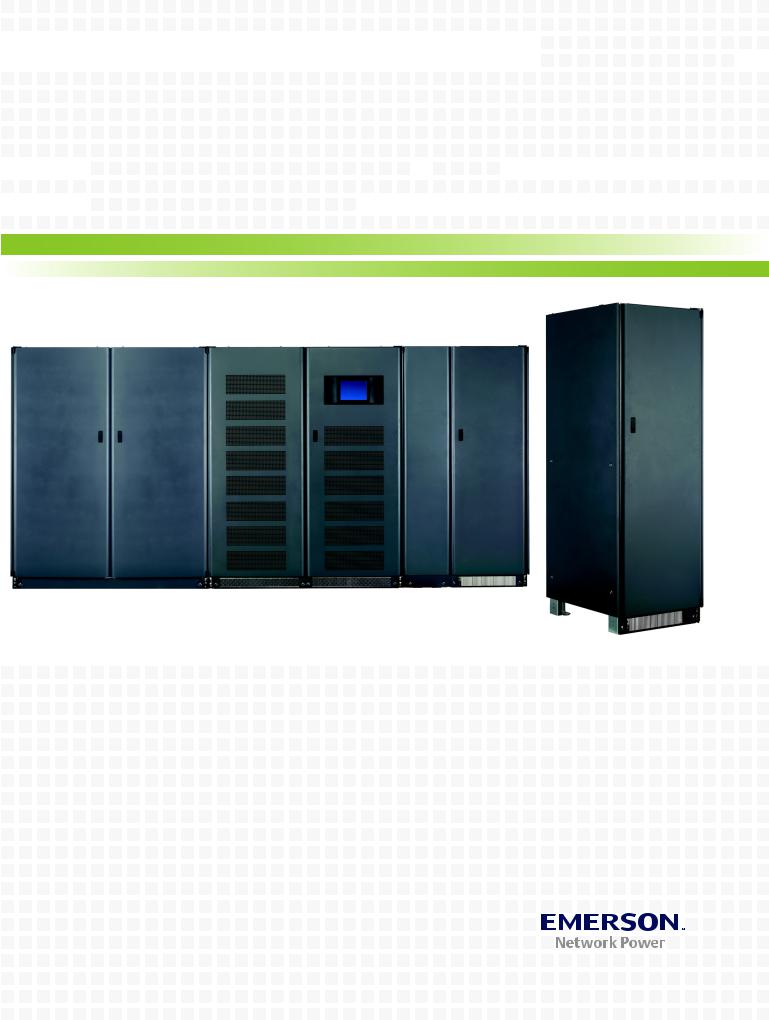





























 AC Power
AC Power





























 For Business-Critical Continuity™
For Business-Critical Continuity™ 





 Liebert® NXL™ Maintenance Bypass
Liebert® NXL™ Maintenance Bypass Cabinet
Cabinet 


















 Installation Manual – 250-400kVA, 60Hz
Installation Manual – 250-400kVA, 60Hz 






















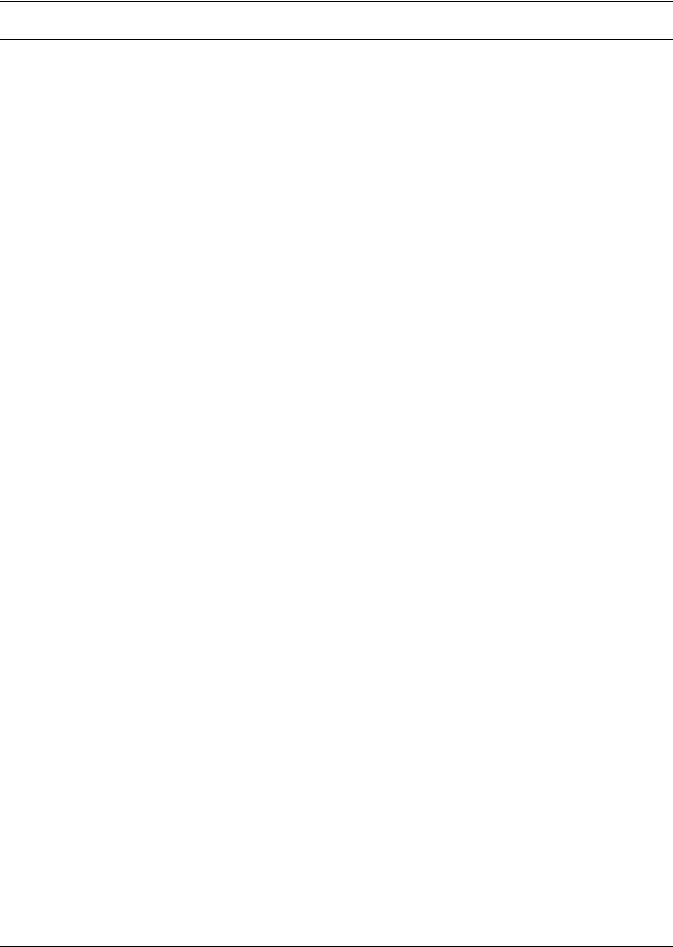
CONTACTING LIEBERT FOR SUPPORT
To contact Emerson Network Power Liebert Services for information or repair service in the United States, call 1-800-LIEBERT (1-800-543-2378). Liebert Services offers a complete range of start-up services, repair services, preventive maintenance plans and service contracts.
For repair or maintenance service outside the 48 contiguous United States, contact Liebert Services, if available in your area. For areas not covered by Liebert Services, the authorized distributor is responsible for providing qualified, factory-authorized service.
For Liebert Services to assist you promptly, have the following information available: Part Numbers: ________________________________________________________________
Serial Numbers: _______________________________________________________________
kVA Rating: __________________________________________________________________
Date Purchased: _______________________________________________________________
Date Installed: ________________________________________________________________
Location: _____________________________________________________________________
Input Voltage/Frequency: ______________________________________________________
Output Voltage/Frequency: _____________________________________________________
Product Warranty Registration
To register for warranty protection, visit the Service and Support section of our Web site at: www.liebert.com
Click on Product Registration and fill out the form.

TABLE OF CONTENTS
IMPORTANT SAFETY INSTRUCTIONS . . . . . . . . . . . . . . . . . . . . . . . . . . . . . . . . . . . . . . . . . . . . . . . .1
1.0 SINGLE-MODULE MECHANICAL INSTALLATION . . . . . . . . . . . . . . . . . . . . . . . . . . . . . . . . . . .2
1.1 Introduction . . . . . . . . . . . . . . . . . . . . . . . . . . . . . . . . . . . . . . . . . . . . . . . . . . . . . . . . . . . . . . . . 2
1.2 Preliminary Checks . . . . . . . . . . . . . . . . . . . . . . . . . . . . . . . . . . . . . . . . . . . . . . . . . . . . . . . . . . 2
1.3 Environmental Considerations . . . . . . . . . . . . . . . . . . . . . . . . . . . . . . . . . . . . . . . . . . . . . . . . . 2
1.3.1 Room . . . . . . . . . . . . . . . . . . . . . . . . . . . . . . . . . . . . . . . . . . . . . . . . . . . . . . . . . . . . . . . . . . . . . . . 2
1.3.2 Storage . . . . . . . . . . . . . . . . . . . . . . . . . . . . . . . . . . . . . . . . . . . . . . . . . . . . . . . . . . . . . . . . . . . . . 3
1.4 Positioning . . . . . . . . . . . . . . . . . . . . . . . . . . . . . . . . . . . . . . . . . . . . . . . . . . . . . . . . . . . . . . . . . 3
1.4.1 Moving the Cabinets. . . . . . . . . . . . . . . . . . . . . . . . . . . . . . . . . . . . . . . . . . . . . . . . . . . . . . . . . . . 3
1.4.2 Clearances. . . . . . . . . . . . . . . . . . . . . . . . . . . . . . . . . . . . . . . . . . . . . . . . . . . . . . . . . . . . . . . . . . . 3
1.4.3 Floor Installation/Anchoring . . . . . . . . . . . . . . . . . . . . . . . . . . . . . . . . . . . . . . . . . . . . . . . . . . . . 3
1.5 Cable Entry. . . . . . . . . . . . . . . . . . . . . . . . . . . . . . . . . . . . . . . . . . . . . . . . . . . . . . . . . . . . . . . . . 3
1.6 Power Cables . . . . . . . . . . . . . . . . . . . . . . . . . . . . . . . . . . . . . . . . . . . . . . . . . . . . . . . . . . . . . . . 4
1.6.1 Power Cable Connection Procedure. . . . . . . . . . . . . . . . . . . . . . . . . . . . . . . . . . . . . . . . . . . . . . . 5
2.0 INSTALLATION DRAWINGS. . . . . . . . . . . . . . . . . . . . . . . . . . . . . . . . . . . . . . . . . . . . . . . . . .7
3.0 SPECIFICATIONS . . . . . . . . . . . . . . . . . . . . . . . . . . . . . . . . . . . . . . . . . . . . . . . . . . . . . . . .26
i

|
FIGURES |
|
Figure 1 |
Cabinet arrangement—Liebert NXL UPS, battery cabinets, maintenance bypass cabinet. . . . . |
. 4 |
Figure 2 |
Two-Breaker Maintenance Bypass Cabinet, one-input, attached . . . . . . . . . . . . . . . . . . . . . . . . . |
. 7 |
Figure 3 |
Two-Breaker Maintenance Bypass Cabinet, two-input, attached . . . . . . . . . . . . . . . . . . . . . . . . . . |
8 |
Figure 4 |
Two-Breaker Maintenance Bypass Cabinet, three-input, attached or detached . . . . . . . . . . . . . . |
8 |
Figure 5 |
Liebert NXL Maintenance Bypass Cabinet—250 and 300kVA main component location . . . . . . . |
9 |
Figure 6 |
Liebert NXL Maintenance Bypass Cabinet—400kVA main component location . . . . . . . . . . . . . |
10 |
Figure 7 |
Liebert NXL Maintenance Bypass Cabinet—250 and 300kVA outline drawing . . . . . . . . . . . . . |
11 |
Figure 8 |
Liebert NXL Maintenance Bypass Cabinet—400kVA outline drawing. . . . . . . . . . . . . . . . . . . . . |
12 |
Figure 9 |
Liebert NXL Maintenance Bypass Cabinet—250 and 300kVA terminal details . . . . . . . . . . . . . |
13 |
Figure 10 |
Liebert NXL Maintenance Bypass Cabinet—400Kva terminal details. . . . . . . . . . . . . . . . . . . . . |
14 |
Figure 11 |
Cable routing. . . . . . . . . . . . . . . . . . . . . . . . . . . . . . . . . . . . . . . . . . . . . . . . . . . . . . . . . . . . . . . . . . . |
15 |
Figure 12 |
Liebert NXL Maintenance Bypass Cabinet, one-input system, point-to-point wiring |
|
|
to UPS . . . . . . . . . . . . . . . . . . . . . . . . . . . . . . . . . . . . . . . . . . . . . . . . . . . . . . . . . . . . . . . . . . . . . . . . |
16 |
Figure 13 |
Liebert NXL Maintenance Bypass Cabinet, two-input system, point-to-point wiring |
|
|
to UPS. . . . . . . . . . . . . . . . . . . . . . . . . . . . . . . . . . . . . . . . . . . . . . . . . . . . . . . . . . . . . . . . . . . . . . . . |
18 |
Figure 14 |
Liebert NXL Maintenance Bypass Cabinet, three-input system, point-to-point wiring |
|
|
to UPS. . . . . . . . . . . . . . . . . . . . . . . . . . . . . . . . . . . . . . . . . . . . . . . . . . . . . . . . . . . . . . . . . . . . . . . . |
20 |
Figure 15 |
Liebert NXL Maintenance Bypass Cabinet Control wire diagram without interlock . . . . . . . . . |
22 |
Figure 16 |
Liebert NXL Maintenance Bypass Cabinet control wire diagram with interlock. . . . . . . . . . . . . |
23 |
Figure 17 |
Liebert NXL Maintenance Bypass Cabinet control wire routing. . . . . . . . . . . . . . . . . . . . . . . . . . |
24 |
Figure 18 |
Ground strap location for connected cabinets . . . . . . . . . . . . . . . . . . . . . . . . . . . . . . . . . . . . . . . . . |
25 |
|
TABLES |
|
Table 1 |
Liebert-supplied interconnect wiring for one-input Liebert NXL Maintenance |
|
|
Bypass Cabinet . . . . . . . . . . . . . . . . . . . . . . . . . . . . . . . . . . . . . . . . . . . . . . . . . . . . . . . . . . . . . . . . . |
17 |
Table 2 |
Liebert-supplied interconnect wiring for two-input Liebert NXL Maintenance |
|
|
Bypass Cabinet. . . . . . . . . . . . . . . . . . . . . . . . . . . . . . . . . . . . . . . . . . . . . . . . . . . . . . . . . . . . . . . . . |
19 |
Table 3 |
Liebert-supplied interconnect wiring for three-input Liebert NXL Maintenance |
|
|
Bypass Cabinet. . . . . . . . . . . . . . . . . . . . . . . . . . . . . . . . . . . . . . . . . . . . . . . . . . . . . . . . . . . . . . . . . |
21 |
Table 4 |
Control wiring connections without interlock . . . . . . . . . . . . . . . . . . . . . . . . . . . . . . . . . . . . . . . . . |
22 |
Table 5 |
Control wiring connections with interlock. . . . . . . . . . . . . . . . . . . . . . . . . . . . . . . . . . . . . . . . . . . . |
23 |
Table 6 |
Liebert NXL Maintenance Bypass Cabinet specifications . . . . . . . . . . . . . . . . . . . . . . . . . . . . . . . |
26 |
Table 7 |
Liebert NXL Maintenance Bypass Cabinet current ratings—System Input . . . . . . . . . . . . . . . . |
27 |
Table 8 |
Liebert NXL Maintenance Bypass Cabinet current ratings—System Output . . . . . . . . . . . . . . . |
27 |
Table 9 |
Recommended conduit and cable sizes—Maintenance Bypass Input . . . . . . . . . . . . . . . . . . . . . . |
27 |
Table 10 |
Recommended conduit and cable sizes—Rectifier Input (1-Input System) . . . . . . . . . . . . . . . . . . |
27 |
Table 11 |
Recommended conduit and cable sizes—Module Bypass Input . . . . . . . . . . . . . . . . . . . . . . . . . . . |
28 |
Table 12 |
Recommended conduit and cable sizes—Module Output . . . . . . . . . . . . . . . . . . . . . . . . . . . . . . . . |
28 |
Table 13 |
Recommended conduit and cable sizes—Load Output . . . . . . . . . . . . . . . . . . . . . . . . . . . . . . . . . . |
28 |
Table 14 |
Recommended conduit and cable sizes—Load Bank Output . . . . . . . . . . . . . . . . . . . . . . . . . . . . . |
28 |
Table 15 Recommended lug sizes . . . . . . . . . . . . . . . . . . . . . . . . . . . . . . . . . . . . . . . . . . . . . . . . . . . . . . . . . . |
29 |
|
ii

IMPORTANT SAFETY INSTRUCTIONS
SAVE THESE INSTRUCTIONS
This manual contains important instructions that should be followed during installation of your Liebert NXL™ Maintenance Bypass Cabinet.
! WARNING
Exercise extreme care when handling cabinets to avoid equipment damage or injury to personnel. The Liebert NXL Maintenance Bypass Cabinet weight ranges from 700 to 900 lb (317 to 409kg).
Locate center of gravity symbols and determine unit weight before handling each cabinet. Test lift and balance the cabinets before transporting. Maintain minimum tilt from vertical at all times.
Slots at the base of the cabinets are intended for forklift use. Base slots will support the unit only if the forks are completely beneath the unit.
In case of fire involving electrical equipment, use only carbon dioxide fire extinguishers or those approved for use in fighting electrical fires.
Extreme caution is required when performing maintenance.
Be constantly aware that the system contains high DC as well as AC voltages. Check for voltage with both AC and DC voltmeters prior to making contact.
Read this manual thoroughly before working with the maintenance bypass cabinet. Retain this manual for use by installing personnel.
! WARNING
Under typical operation and with all doors closed, only normal safety precautions are necessary. The area around the system should be kept free of puddles of water, excess moisture and debris.
Special safety precautions are required for procedures involving handling, installation and maintenance of the Maintenance Bypass Cabinet. Observe all safety precautions in this manual before handling or installing the Maintenance Bypass Cabinet. Observe all precautions in the Operation and Maintenance Manual, before as well as during performance of all maintenance procedures.
This equipment contains circuits that are energized with high voltage. Only test equipment designed for troubleshooting should be used. This is particularly true for oscilloscopes. Always check with an AC and DC voltmeter to ensure safety before making contact or using tools. Even when the power is turned Off, dangerously high potential electric charges may exist.
All power and control wiring should be installed by a qualified electrician. All power and control wiring must comply with the NEC and applicable local codes.
ONLY properly trained and qualified personnel should perform maintenance on the Maintenance Bypass Cabinet. When performing maintenance with any part of the equipment under power, service personnel and test equipment should be standing on rubber mats. The service personnel should wear insulating shoes for isolation from direct contact with the floor ground.
One person should never work alone, even if all power is removed from the equipment. A second person should be standing by to assist and summon help in case of an accident.
! CAUTION
This unit complies with the limits for a Class A digital device, pursuant to Part 15 Subpart J of the FCC rules. These limits provide reasonable protection against harmful interference in a commercial environment. This unit generates, uses and radiates radio frequency energy and, if not installed and used in accordance with this instruction manual, may cause harmful interference to radio communications. Operation of this unit in a residential area may cause harmful interference that the user must correct at his own expense.
NOTE
Liebert Corporation neither recommends nor knowingly sells this product for use with life support or other FDA-designated “critical” devices.
1
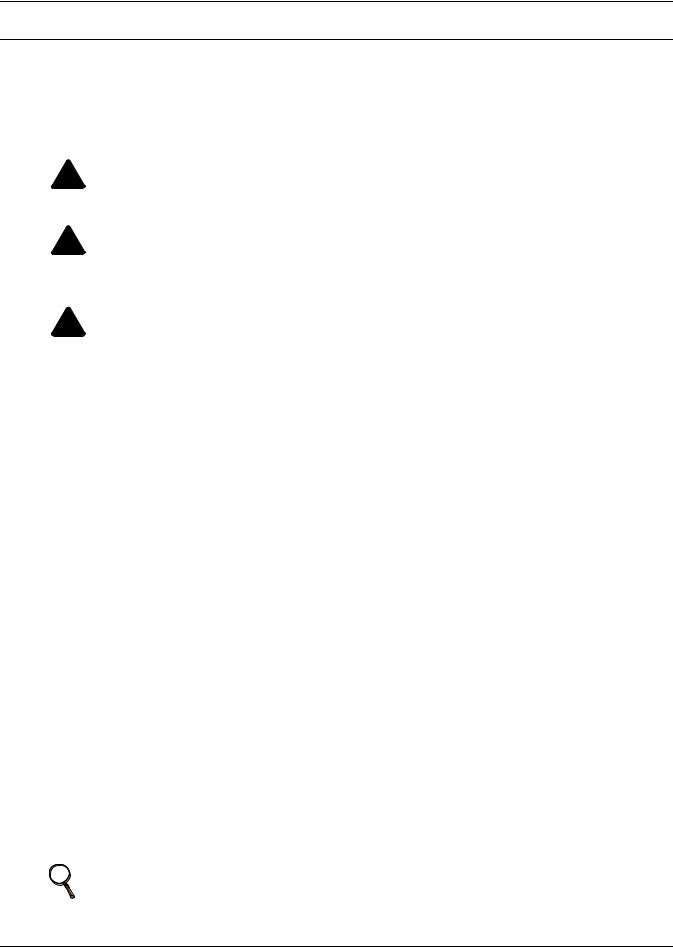
Single-Module Mechanical Installation
1.0SINGLE-MODULE MECHANICAL INSTALLATION
1.1Introduction
This section describes the requirements that must be taken into account when planning the positioning and cabling of the Liebert NXL Maintenance Bypass Cabinet.
This chapter is a guide to general procedures and practices that should be observed by the installing engineer. The particular conditions of each site will determine the applicability of such procedures.
! WARNING
Do not apply electrical power to the UPS equipment before the arrival of the commissioning engineer.
! WARNING
The Maintenance Bypass Cabinet should be installed by a qualified engineer in accordance with the information contained in this chapter and all equipment not referred to this manual is shipped with details of its own mechanical and electrical installation.
! WARNING
Eye protection should be worn to prevent injury from accidental electrical arcs. Remove rings, watches and all metal objects. Only use tools with insulated handles. Wear rubber gloves.
NOTICE
Three-phase input supply required.
The standard Liebert NXL UPS is suitable for connection to three-phase, four-wire (+ Earth) TN-C, TN-S, IT-G, IT-IG or three-phase, three-wire plus ground, IT-UG.
If using the Liebert NXL UPS with an IT Power system, a four-pole disconnect device must be included as part of building installation.
1.2Preliminary Checks
Before installing the Maintenance Bypass Cabinet, carry out the following preliminary checks:
•Visually examine the equipment for transit damage, both internally and externally. Report any damage to the shipper immediately.
•Verify that the correct equipment is being installed. The equipment supplied has an identification tag on the back of the main door reporting: the type, size and main calibration parameters of the UPS.
•Verify that the room satisfies the environmental conditions stipulated in the equipment specifications, paying particular attention to the ambient temperature and air exchange system.
1.3Environmental Considerations
1.3.1Room
The Maintenance Bypass Cabinet is intended for indoor installation and should be located in a cool, dry, clean-air environment with adequate ventilation to keep the ambient temperature within the specified operating range (see 3.0 - Specifications).
All models of the Liebert NXL Maintenance Bypass Cabinet are convection-cooled. To permit air to enter and exit and prevent overheating or malfunctioning, do not cover the ventilation openings.
When bottom entry is used, the conduit plate can be removed and punched and replaced. The bottom conduit plate must be replaced for proper airflow. If necessary to cool the room, install a system of room extractor fans.
NOTE
The Maintenance Bypass Cabinet is suitable for mounting on concrete or other noncombustible surface only.
2
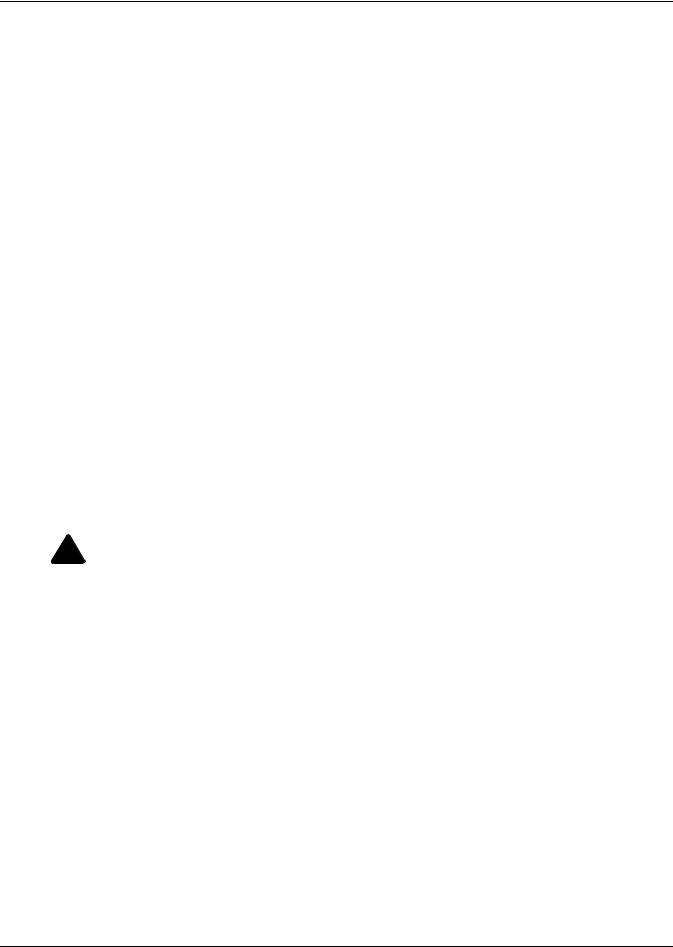
Single-Module Mechanical Installation
1.3.2Storage
Should the equipment not be installed immediately, it must be stored in a room for protection against excessive humidity and or heat sources (see Table 6).
1.4Positioning
The cabinet is structurally designed to handle lifting from the base.
Access to the power terminals, auxiliary terminals blocks and power switches is from the front.
The top and front removable panels are secured to the chassis by screws. The door can be opened to give access to the power connections bars, auxiliary terminal blocks and power isolators. Front door can be opened at 180° for better Service and more flexibility in installations.
1.4.1Moving the Cabinets
The route to be travelled between the point of arrival and the unit’s position must be planned to make sure that all passages are wide enough for the unit and that floors are capable of supporting its weight (for instance, check that doorways, lifts, ramps, etc. are adequate and that there are no impassable corners or changes in the level of corridors).
Ensure that the cabinet weight is within the designated surface weight loading (kg/cm2) of any handling equipment. See Table 6 for weight.
Ensure that any lifting equipment used in moving the cabinet has sufficient lifting capacity.
The Maintenance Bypass Cabinet can be handled by means of a fork lift or similar equipment. For operations with a fork lift, refer to installation drawings in 2.0 - Installation Drawings.
Because the weight distribution in the cabinet is uneven, use extreme care during handling and transporting.
When moving the unit by forklift, care must be taken to protect the panels. Do not exceed a 15-degree tilt with the forklift. Bottom structure will support the unit only if the forks are completely beneath the unit.
Handling the unit with straps is not authorized.
! CAUTION
Take extreme care when handling Maintenance Bypass Cabinets to avoid equipment damage or injury to personnel.
1.4.2Clearances
Liebert NXL Maintenance Bypass Cabinets have no ventilation grilles at either side or at the rear. Clearance around the front of the equipment should be sufficient to enable free passage of personnel with the doors fully opened. It is important to leave a distance of 24" (610mm) between the top of the cabinet and any overhead obstacles to permit adequate circulation of air coming out of the unit.
1.4.3Floor Installation/Anchoring
The installation diagrams in 2.0 - Installation Drawings of this manual identify the location of the holes in the base plate through which the equipment can be bolted to the floor. If the equipment is to be located on a raised floor it should be mounted on a pedestal suitably designed to accept the equipment point loading. Refer to the base view to design this pedestal.
1.5Cable Entry
Cables can enter the Maintenance Bypass Cabinet from the bottom or top.
3
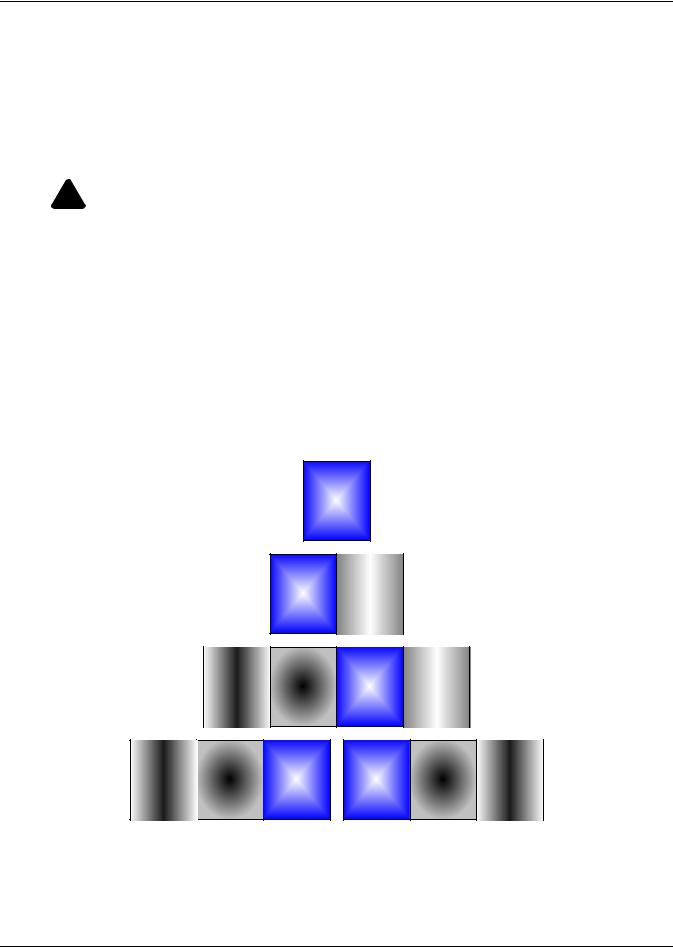
Single-Module Mechanical Installation
1.6Power Cables
The Maintenance Bypass Cabinet requires both power and control cabling once it has been mechanically installed. All control cables must be separate from the power cables. Run control cables in metal conduits or metal ducts that are electrically bonded to the cabinets they are connected to.
The cable design must comply with the voltages and currents provided in Tables 7 and 8, follow local wiring practices and take into consideration the environmental conditions (temperature and physical support media).
For cable entry terminal, refer to Figure 9.
! WARNING
Before cabling up the cabinet, ensure that you are aware of the location and operation of the external isolators that connect the input/bypass supply.
Check that these supplies are electrically isolated, and post any necessary warning signs to prevent their inadvertent operation.
The following are guidelines only and superseded by local regulations and codes of practice where applicable:
•Take special care when determining the size of the neutral cable (grounded conductor), because current circulating on the neutral cable may be greater than nominal current in the case of nonlinear loads. Refer to Tables 7 and 8.
•The grounding conductor should be sized according to the fault rating, cable lengths, type of protection, etc. The grounding cable connecting the UPS to the main ground system must follow the most direct route possible.
•Consider using smaller, paralleled cables for heavy currents as a way of easing installation.
Figure 1 Cabinet arrangement—Liebert NXL UPS, battery cabinets, maintenance bypass cabinet
Liebert
NXL
UPS
Liebert
NXL
UPS
Maintenance |
Note: If a maintenance bypass |
cabinet is used, it must be |
|
Bypass |
installed on the right side of |
Cabinet |
the Liebert NXL UPS |
Additional |
Battery |
Liebert |
Maintenance |
|
Battery |
NXL |
Bypass |
||
Cabinet |
||||
Cabinet(s) |
|
UPS |
Cabinet |
|
|
|
|
Additional
Battery Battery
Cabinet(s) Cabinet
Liebert
NXL
UPS
Liebert
NXL
UPS
Additional
Battery Battery
Cabinet Cabinet(s)
4
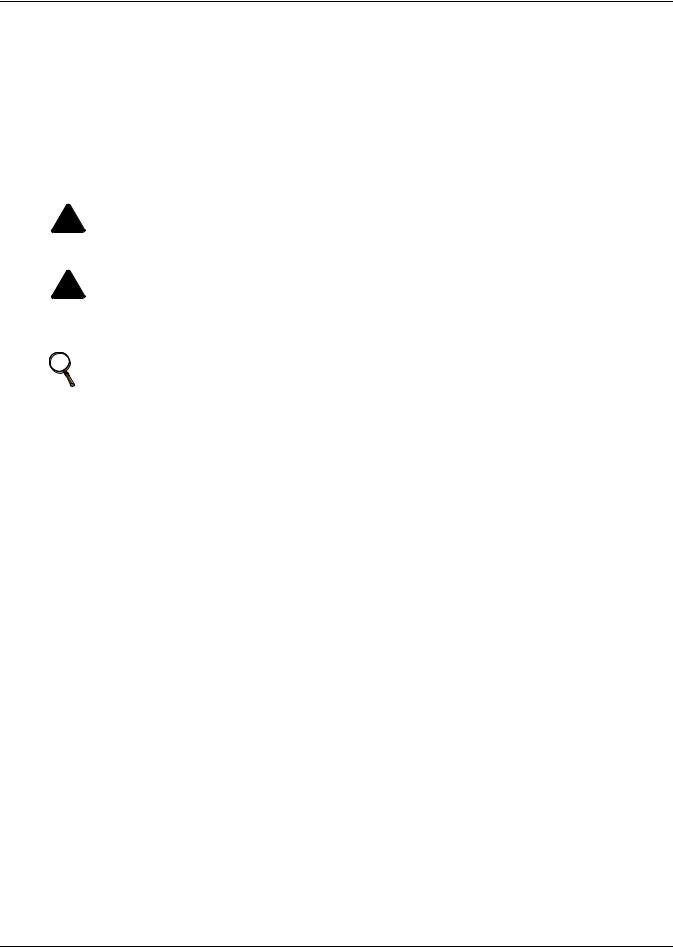
Single-Module Mechanical Installation
1.6.1Power Cable Connection Procedure
The system input, UPS bypass, UPS output and system output cables (all require lug type terminations) are connected to busbars situated behind the power isolator switches as shown in 2.0 - Installation Drawings. These are accessible when the power compartment door is opened.
Equipment Ground
The equipment ground busbar is located near the input and output power supply connections as shown in 2.0 - Installation Drawings. The grounding conductor must be connected to the ground busbar.
All cabinets and cable trunking should be grounded in accordance with local regulations.
! WARNING
Failure to follow adequate grounding procedures can result in electric shock hazard to personnel, or the risk of fire, should an ground fault occur.
! WARNING
The operations described in this section must be performed by authorized electricians or qualified technical personnel. If you have any difficulties, do not hesitate to contact Emerson Network Power Liebert Services. See the back page of this manual for contact information.
NOTE
Proper grounding considerably reduces problems in systems caused by electromagnetic interference.
5
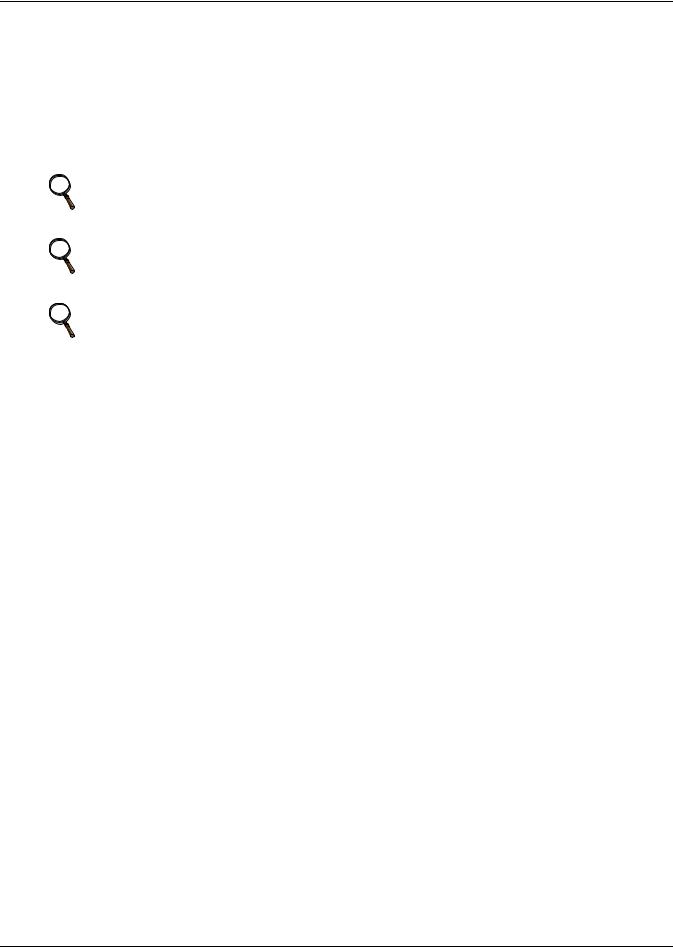
Single-Module Mechanical Installation
Once the equipment has been finally positioned and secured, connect the power cables as described in the following procedure.
Refer to the appropriate cable connection drawing in 2.0 - Installation Drawings.
1.Verify that the bypass equipment is isolated from its external power source and all the power isolators are open. Check that these supplies are electrically isolated and post any necessary warning signs to prevent their inadvertent operation.
2.Open the door to the cabinet and remove the interior panels.
3.Connect the ground and any necessary main bonding jumper to the equipment ground busbar.
NOTE
The grounding and neutral bonding arrangement must be in accordance with local and national codes of practice.
NOTE
Care must be taken when routing power cable. Ensure that cables do not touch other busbars (see Figure 11).
NOTE
Do not double-stack lugs: do not layer two lugs on the same side of the busbar (see Figure 11).
4.Connect the AC input supply cables between the power distribution panel and the bypass input supply busbars (A-B-C or A-B-C-N terminals) and tighten the connections to the proper torque. Ensure correct phase rotation!
5.If system is oneor two-input, connect the AC input supply cables between the maintenance bypass cabinet and the UPS bypass input supply busbars (A-B-C or A-B-C-N terminals) and tighten the connections to the proper torque.
Ensure correct phase rotation!
6.If system is single-input, connect AC jumper connectors between UPS bypass input supply busbars and UPS rectifier input supply busbars (A-B-C terminals) and tighten the connections to the proper torque.
Ensure correct phase rotation!
7.Connect the system output power cables between the Maintenance Bypass Cabinet output (A-B-C or A-B-C-N terminals) and the critical load and tighten the connections to the proper torque. Ensure correct phase rotation!
8.Connect the auxiliary cables of any external interface/signals to the respective connections of the output auxiliary terminal block (X4) (see2.0 - Installation Drawings).
9.Replace interior panels and close door.
6
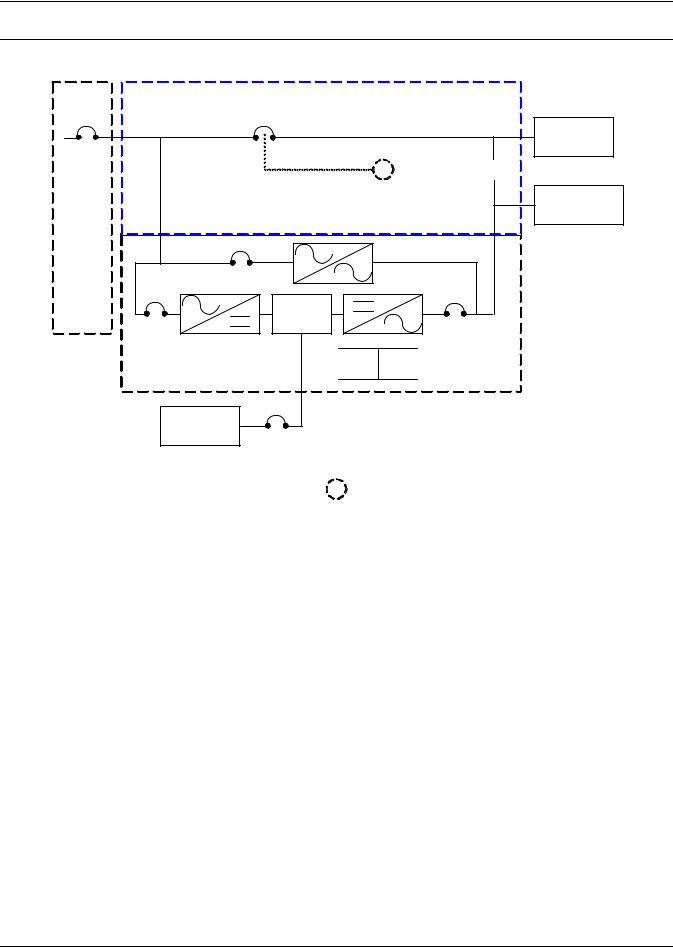
Installation Drawings
2.0INSTALLATION DRAWINGS
Figure 2 Two-Breaker Maintenance Bypass Cabinet, one-input, attached
Two Breaker Maintenance Bypass Cabinet
FBO |
MBB |
I
Critical
Load

 MIB
MIB
Load Bank
(FBO)
|
|
BFB |
|
|
CB1 |
DC Bus |
CB2 |
|
|
||
Main Input |
|
|
N |
Switchgear |
UPS Module |
|
MBJ |
|
|
EG |
|
|
|
|
|
|
Battery |
|
MIB - Maintenance Isolation Breaker |
|
|
MBB - Maintenance Bypass Breaker |
|
|
System |
MBD |
|
|
FBO – Furnished By Others |
||
|
|
|
N – Neutral |
|
|
|
EG – Equipment Ground |
|
|
|
MBJ – Main Bonding Jumper(3-wire systems only) |
|
|
|
I - Option Interlock |
7
